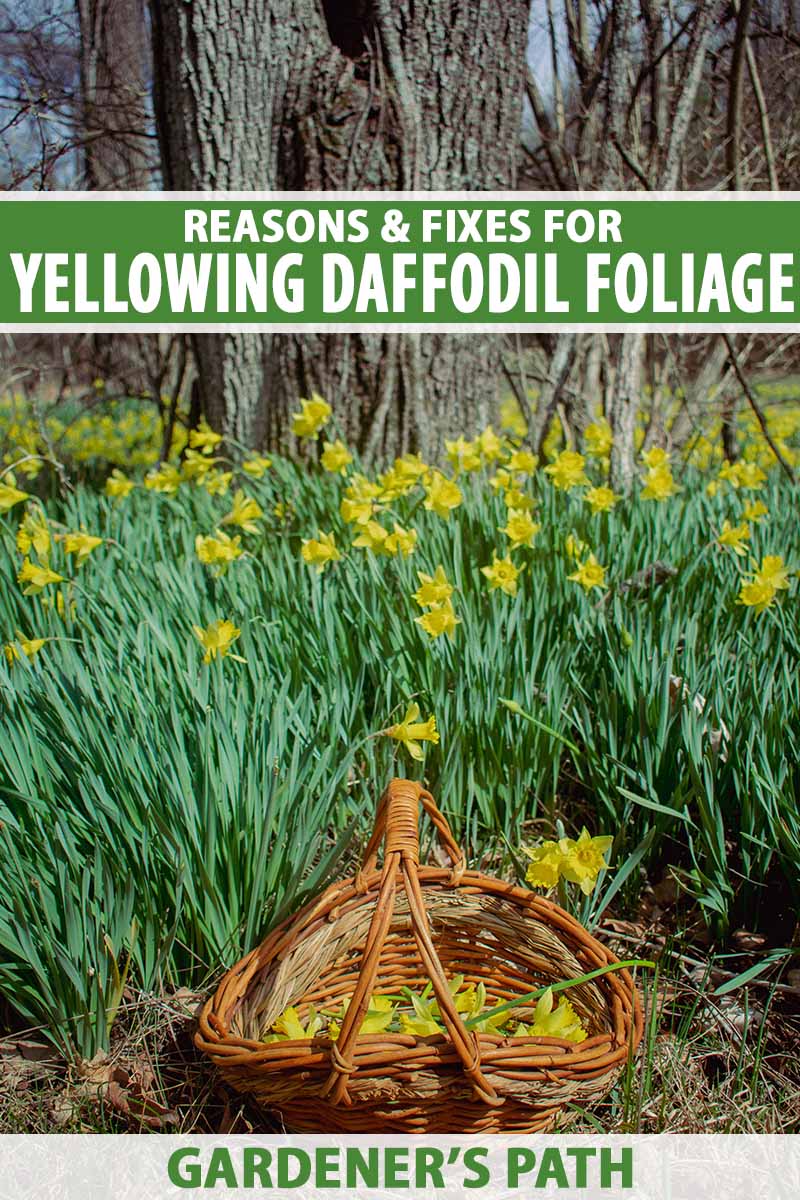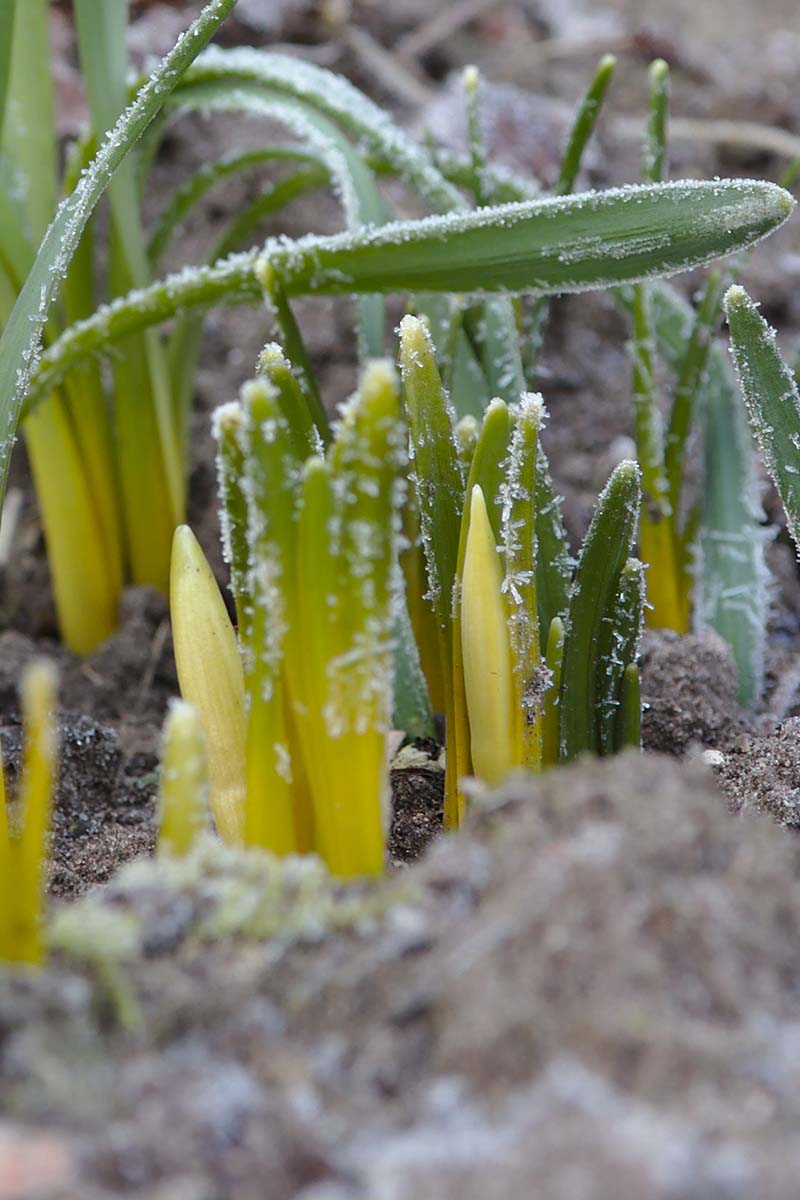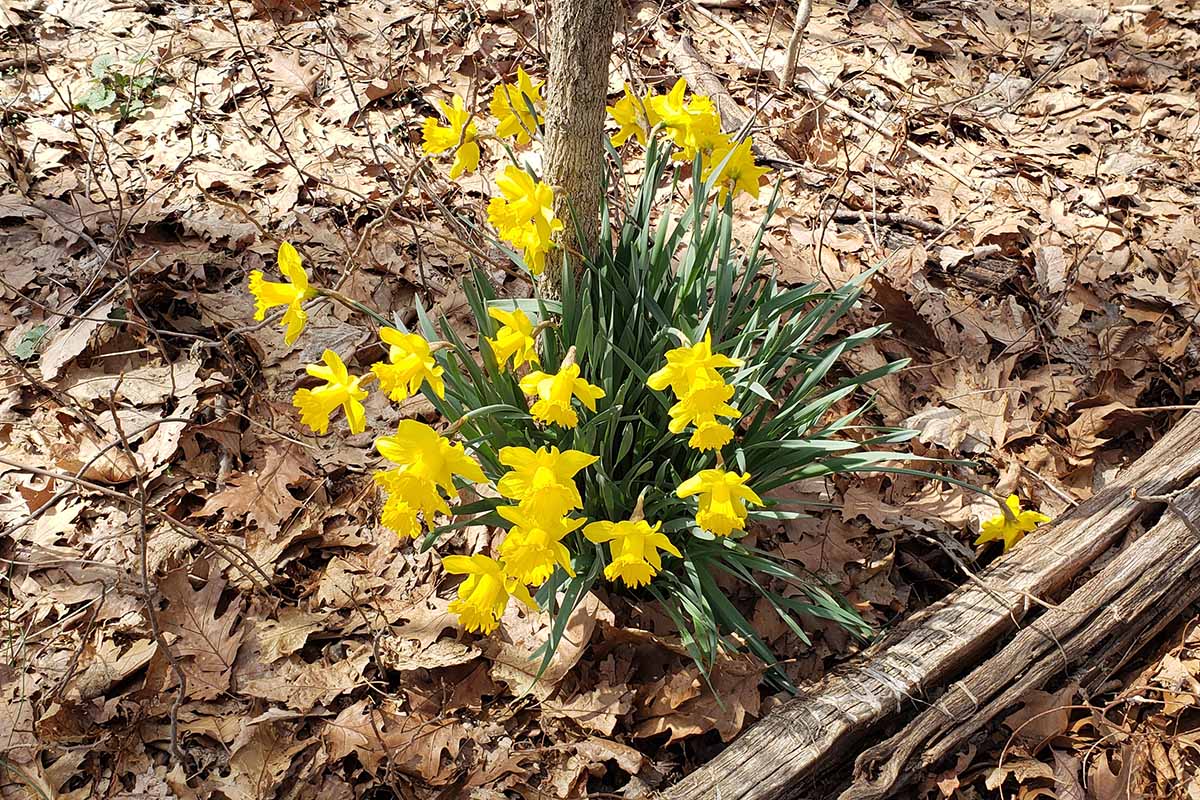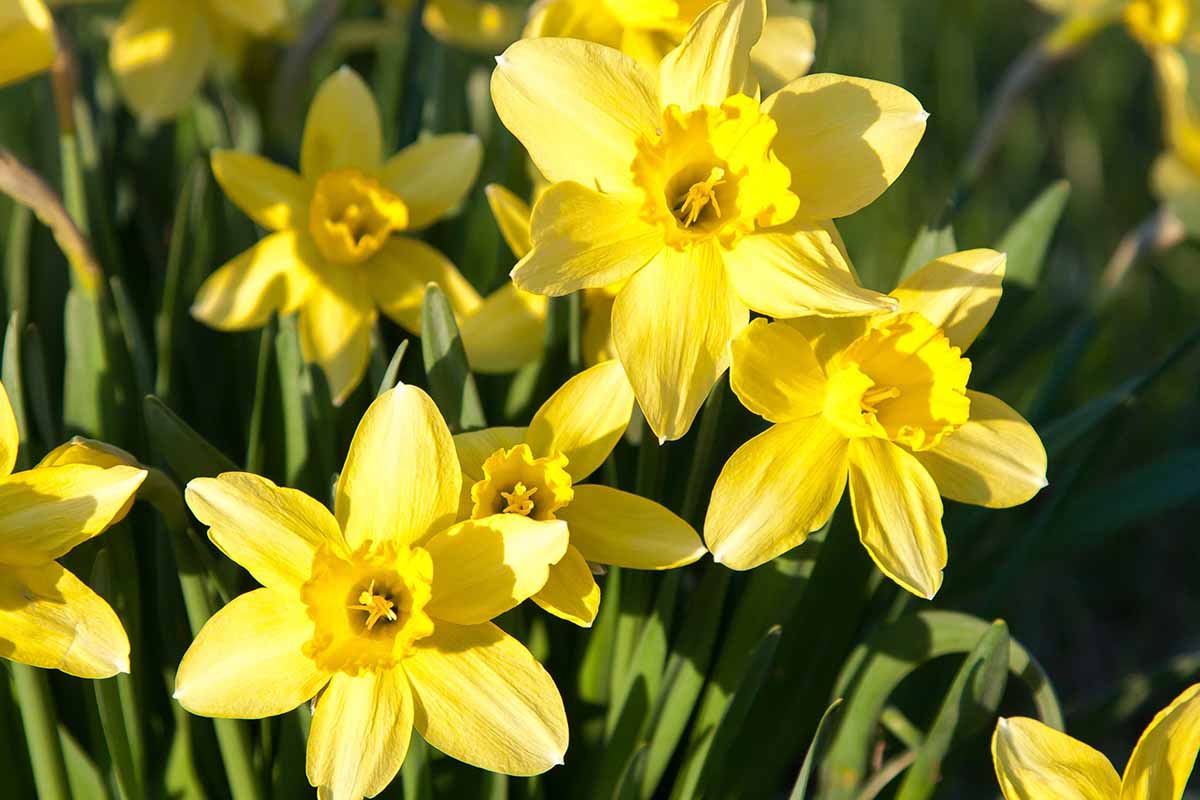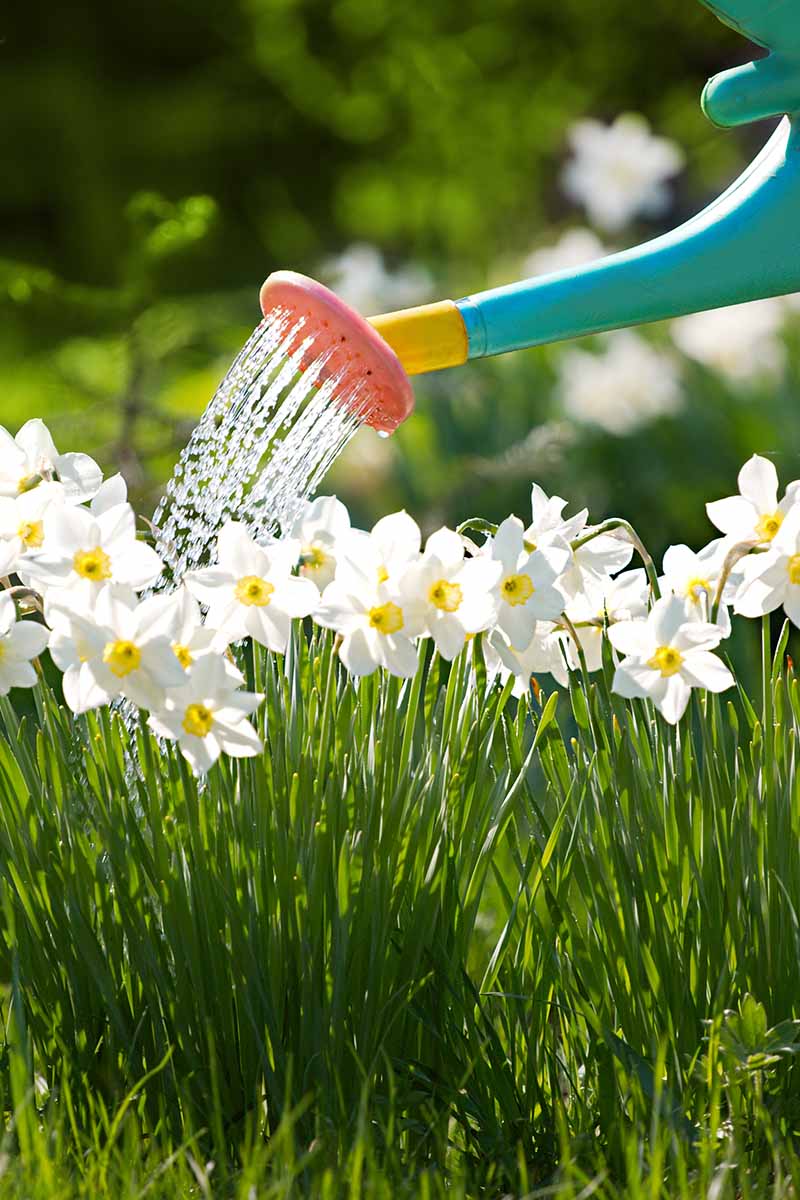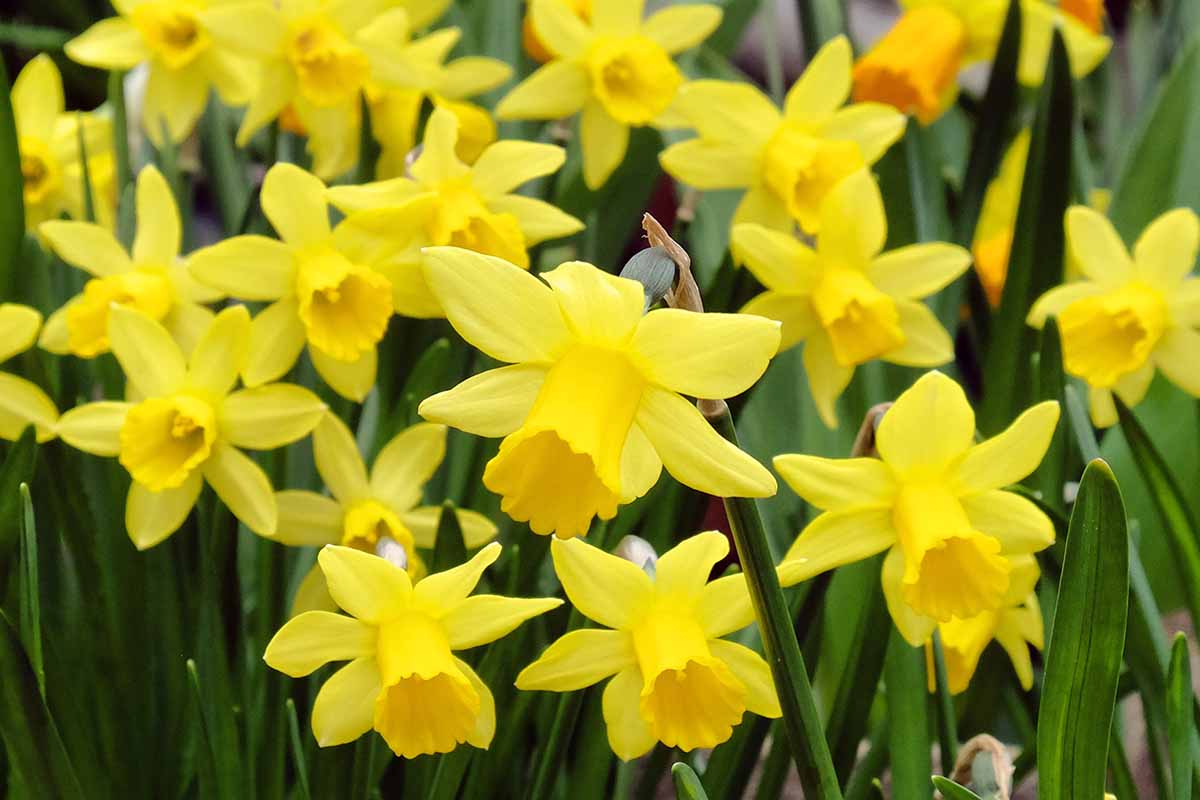Their rich green foliage and cheerful blooms are delightful, so it’s only natural to feel concerned when the foliage starts turning yellow. We link to vendors to help you find relevant products. If you buy from one of our links, we may earn a commission. At times, your plants may be completely fine, and they are just moving through their seasonal life cycle. Other times, this may be a sign of disease, and your bulbs will need to be checked and discarded promptly to prevent further spread if harmful pathogens are present. Read on to diagnose some potential causes of yellowing daffodil leaves and discover ways you can prevent it. Here’s a preview of the main causes: Ready to find out what might be affecting the foliage on your plants, and what needs to be done to prevent future problems? Let’s begin!
1. Basal Rot
Fusarium oxysporum is a soil-borne fungus that poses a great danger to daffodil bulbs. Once infected with this fungal pathogen, bulbs cannot be salvaged, so prevention is key. Before planting, check your bulbs carefully. If there is a pinkish-white fungus on the basal plate or a softness to the bulb, do not plant it in the soil. Keep any affected ones that you find away from healthy bulbs, and discard them immediately. Do not store damaged bulbs, as these are susceptible to disease. Affected bulbs may not bloom at all, or premature yellowing of the foliage may occur. Daffodil growth may appear stunted. If left untreated, a dark purple discoloration will start to appear at the base and move up the leaves, and the bulb will eventually be desiccated. If you suspect basal rot, dig up the bulbs to inspect them for any softness or evidence of fungus. Upon inspecting them, discard any rotting ones, treat the remaining healthy bulbs with a fungicide like thiabendazole, then store them properly and replant when the soil is cool in the fall.
2. Lack of Sunlight
If your daffodils are planted in full shade, they are not receiving the correct amount of sunlight. Daffodils need at least six hours of sun each day and will not bloom if they’re not getting enough. If you notice that your daffodil leaves are yellowing but they failed to bloom, check to make sure they’re receiving an adequate number of hours of sunlight. If they aren’t, try digging up the bulbs, checking to make sure they look healthy, and replanting them in a sunnier area. After your plants have bloomed, it can be tempting to cut back the green or yellowing foliage, or even to band or braid it, as has sometimes been done traditionally. Doing this will limit the amount of sunlight the leaves have access to, and this will prevent the plants from conducting photosynthesis and recharging the bulbs’ energy supply for the following season. Instead, leave the foliage alone until it’s completely yellow and wilted, or even until the leaves have turned brown and dried out. This ensures that the foliage has successfully finished replenishing the bulb’s energy stores.
3. Leaf Scorch
Peyronellaea curtisii is a fungal pathogen that causes leaf scorch disease. It lives on the necks and foliage of daffodils and is evidenced by yellowing leaves with reddish-brown tips, and brown spots on the foliage. The leaf tissue around the brown spots will turn gray and die. To prevent this disease from spreading, trim the affected foliage off promptly and discard it. If signs of infection persist, or if all of the leaves are affected, dig out the affected bulbs and dispose of them. If this disease is found to be the culprit, remove and discard affected bulbs to prevent further spread, and try to rotate beds every year for at least three years by lifting healthy bulbs in the summer after the leaves have died back, storing them properly, then planting them in a different bed in the fall. While the fungi that cause leaf scorch may survive on the necks and foliage of daffodils, it can be spread through soil and on garden tools as well. Make sure to sanitize your garden tools with a bleach and water solution after use, made with a solution of nine parts water to one part bleach. Sanitize your gardening shoes and try to avoid tracking potentially contaminated soil into other areas of the garden.
4. Maturity
If your daffodil blooms have already come and gone, it’s natural and expected for the foliage to gradually begin turning yellow. The green leaves have been conducting photosynthesis through the peak of their growing season, and sending that energy back into the bulbs. Once they’ve finished their job, it’s time for them to die back and for the bulbs to go into dormancy. This is a necessary step to keep your bulbs alive and fed for future seasons, so be sure to let the leaves turn fully yellow and then brown, completely unhindered, before cutting them off. This process generally begins about six weeks after flowering and continues into the summer months. If you wait until the process of dying back is complete, you can easily pull the leaves off after the foliage turns brown.
5. Narcissus Yellow Stripe Virus
If you’ve noticed light green, grayish-green, or bright yellow streaks or splotchy marks on the upper two-thirds of your daffodil leaves, narcissus yellow stripe virus may be at work. The foliage may also appear to be distorted in a variety of ways, with bent, twisted, or contorted leaves. As there is no known cure for this virus, you must discard affected bulbs to prevent further spread. Keep an eye out for aphids, as they can contribute to the spread of this virus. You can also play it safe and purchase bulbs that are certified virus-free in an effort to prevent introducing this virus into your garden.
6. Nutrient Deficiency
A nutrient deficiency may be the culprit if leaves are yellowing prematurely. The first thing to check for when a nutrient deficiency is suspected is overcrowding. Over time, bulbs multiply, so even when they were originally planted far enough apart, they may eventually suffer from a lack of available space. If you have far too many bulbs crammed into the same area, they’ll all be competing for the available water and nutrients in the soil. This could prevent them from blooming or cause foliage to turn yellow prematurely. To remedy this situation, divide and replant your bulbs to provide them ample space and access to soil nutrients. If your prematurely yellowing daffodil plants are not overcrowded, they’re receiving enough sunlight, and they aren’t displaying other signs of disease, they may be suffering from a nutrient deficiency nonetheless, and they could benefit from a serving of fertilizer. This can be determined by conducting a soil test. Having a soil sample of your planting bed analyzed will tell you what nutrients are lacking, and you can fertilize accordingly. Learn more about how to fertilize daffodils in our guide.
7. Root Rot
If your daffodil leaves look yellow, stunted, and withered, root rot may be the culprit. Root rot is a fungal infection that can strike when the bulbs are planted in a soggy area, if they are being overwatered, or if they are planted too deep. If you notice root rot symptoms, check to see if the soil is perpetually soggy where the bulbs are planted. Bulbs that look diseased will need to be thrown out, and the remaining healthy ones may need to be relocated to an area with better drainage. If the problem is due to an overwatering issue, cut back on your watering frequency moving forward. Treat the soil and remaining bulbs with a fungicide to prevent root rot from striking in future seasons. As a preventative measure, healthy bulbs can be dipped in a fungicide solution or a granular fungicide can be worked into your garden soil. Whichever method you prefer to use, instructions for use can be found on product labels. Multi-purpose fungicides can be found at your local garden center. Let the yellowing leaves complete their process of recharging the bulbs so they will have the energy required to bloom in the following year, and then you can remove the spent foliage when it turns brown. If yellowing occurs before or during the flowering period, action will need to be taken. Most of these issues cannot be cured when caused by disease pathogens, so prevention is key. If you find yourself needing to store bulbs, do so properly, check them periodically for signs of disease, and remove any that show signs of decay, withering, or disease. Before planting new bulbs, be sure to store them properly in a cool, dry location, out of direct sunlight. Inspect them carefully and discard any squishy, damaged, dried up, moldy-looking, spotted, or otherwise questionable and unhealthy-looking bulbs. Planting only the healthiest bulbs can go a long way in keeping your daffodils safe, and looking their best. Has your daffodil foliage turned yellow? Was one of these causes the culprit? We’d love to hear about your experience. Let us know in the comments! And please feel free to share any questions you may have as well. If this guide helped answer some of your questions about your plants, check out these daffodil guides next:
How to Grow and Care for Delightful Daffodils5 Reasons Why Your Daffodils Aren’t BloomingHow to Divide and Transplant Daffodil Bulbs
